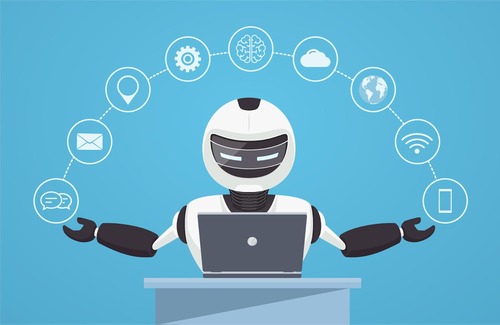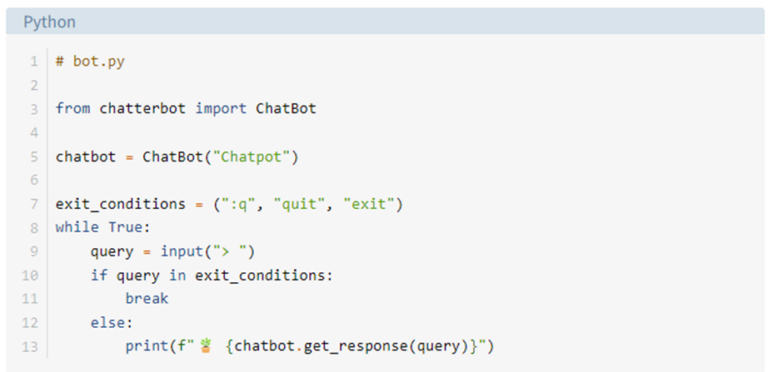Step-by-Step Guide: Build AI Chatbot Using Python
Artificial intelligence chatbots are designed with algorithms that let them simulate human-like conversations through text or voice interactions. Python has become a leading choice for building AI chatbots owing to its ease of use, simplicity, and vast array of frameworks.
It has the ability to seamlessly integrate with other computer technologies such as machine learning and natural language processing, making it a popular choice for creating AI chatbots. This article consists of a detailed python chatbot tutorial to help you easily build an AI chatbot chatbot using Python.
Essential Concepts to Learn before Building a Chatbot in Python
AI chatbots have quickly become a valuable asset for many industries. Building a chatbot is not a complicated chore but definitely requires some understanding of the basics before one embarks on this journey. Once the basics are acquired, anyone can build an AI chatbot using a few Python code lines.

Here are a few essential concepts you must hold strong before building a chatbot in Python.
Definition and Types of Chatbots
In the AI chatbot world, chatbots have primarily two main types:
Rule-based
Rule-based chatbots, also known as scripted chatbots, were the earliest chatbots created based on rules/scripts that were pre-defined. For response generation to user inputs, these chatbots use a pre-designated set of rules. Therefore, there is no role of artificial intelligence or AI here. This means that these chatbots instead utilize a tree-like flow which is pre-defined to get to the problem resolution.
AI Based
On the other hand, an AI chatbot is one which is NLP (Natural Language Processing) powered. This means that there are no pre-defined set of rules for this chatbot. Instead, it will try to understand the actual intent of the guest and try to interact with it more, to reach the best suitable answer.
Common Applications of Chatbots
Individual consumers and businesses both are increasingly employing chatbots today, making life convenient with their 24/7 availability. Not only this, it also saves time for companies majorly as their customers do not need to engage in lengthy conversations with their service reps.

One of the most common applications of chatbots is ordering food. Famous fast food chains such as Pizza Hut and KFC have made major investments in chatbots, letting customers place their orders through them. For instance, Taco Bell’s TacoBot is especially designed for this purpose. It cracks jokes, uses emojis, and may even add water to your order.
Chatbots are also used by airlines for booking flights. Through these chatbots, customers can search and book for flights through text. Customers enter the required information and the chatbot guides them to the most suitable airline option.
There are many other applications for chatbots including providing companionship for Alzheimer’s Disease patients, conducting market research, transportation purposes, providing a medical diagnosis, and for legal guidance.
Key Concepts to Learn Before Building a Chatbot in Python
Before becoming a developer of chatbot, there are some diverse range of skills that are needed. First off, a thorough understanding is required of programming platforms and languages for efficient working on Chatbot development.
Anyone who wishes to develop a chatbot must be well-versed with Artificial Intelligence concepts, Learning Algorithms and Natural Language Processing. There should also be some background programming experience with PHP, Java, Ruby, Python and others. This would ensure that the quality of the chatbot is up to the mark.
How to Make AI Chatbot Using Python?
In recent years, creating AI chatbots using Python has become extremely popular in the business and tech sectors. Companies are increasingly benefitting from these chatbots because of their unique ability to imitate human language and converse with humans.
The big question is: how can you build an AI chatbot using Python? Here is a step-by-step guide to help you through the process.
1Setting Up the Environment
The first crucial step is setting up a developed environment. This means that you must download the latest version of Python (python 3) from its Python official website and have it installed in your computer.
2Designing the Chatbot
After the virtual environment has been set up, now you will create a working command-line chatbot. This chatbot will reply to you but the replies might not be very interesting. Now you will need to install chatterbot using the following commands:

As these commands are run in your terminal application, ChatterBot is installed along with its dependencies in a new Python virtual environment. Now you are ready to begin. Start by creating a new Python file. You can call it bot.py. Now add in the code for running a basic chatbot.

As ChatBot was imported in line 3, a ChatBot instance was created in line 5, with the only required argument being giving it a name. You can call it anything you want, we call it ‘Chatpot’! As you notice, in line 8, a ‘while’ loop was created which will continue looping unless one of the exit conditions from line 7 are met.
Finally, in the last line (line 13) a response is called out from the chatbot and passes it the user input collected in line 9 which was assigned as a query.
3Implementing Natural Language Processing (NLP)
NLP is a branch of artificial intelligence focusing on the interactions between computers and the human language. This enables the chatbot to generate responses similar to humans. In order to train a it in understanding the human language, a large amount of data will need to be gathered. This data can be acquired from different sources such as social media, forums, surveys, web scraping, public datasets or user-generated content.
Once this data is acquired and pre-processed for any misinformation, one of the NLP techniques can be used in building the chatbot such as a rule-based system, keyword-based system, intent recognition, sentiment analysis or machine learning-based system.
4Developing the Chatbot's Backend
A backend API will be able to handle specific responses and requests that the chatbot will need to retrieve. The integration of the chatbot and API can be checked by sending queries and checking chatbot’s responses. It should be ensured that the backend information is accessible to the chatbot.
5Training the AI Chatbot
This step entails training the chatbot to improve its performance. Training will ensure that your chatbot has enough backed up knowledge for responding specifically to specific inputs. ChatterBot comes with a List Trainer which provides a few conversation samples that can help in training your bot.
Here is an example. Execute this command:
my_bot = ChatBot (name=’Chatpot’, read_only=True,
logic_adapters=
[‘chatterbot.logic.MathematicalEvaluation’,
‘chatterbot.logic.BestMatch’])
This particular command will assist the bot in solving mathematical problems. The logic ‘BestMatch’ will help It choose the best suitable match from a list of responses it was provided with.
6Deploying the AI Chatbot
The last step in the process is deployment of your AI chatbot. They are usually integrated on your intranet or a web page through a floating button.
The easiest method of deploying a chatbot is by going on the CHATBOTS page and loading your bot. Click on the ‘Save & Deploy’ button. Then follow the prompts for choosing the medium that you want.
Why is Python the Preferred Programming Language for AI Chatbots?
Over the years, experts have accepted that chatbots programmed through Python are the most efficient in the world of business and technology.

Advantages of Using Python for Chatbot Development
Research suggests that more than 50% of data scientists utilized Python for building chatbots as it provides flexibility. Its language and grammar skills simulate that of a human which make it an easier language to learn for the beginners. The best part about using Python for building AI chatbots is that you don’t have to be a programming expert to begin. You can be a rookie, and a beginner developer, and still be able to use it efficiently.
This is because Python comes with a very simple syntax as compared to other programming languages. A developer will be able to test the algorithms thoroughly before their implementation. Therefore, a buffer will be there for ensuring that the chatbot is built with all the required features, specifications and expectations before it can go live.
Python Libraries and Frameworks for Chatbot Development
In addition to this, Python also has a more sophisticated set of machine-learning capabilities with an advantage of choosing from different rich interfaces and documentation. Without this flexibility, the chatbot’s application and functionality will be widely constrained.
Python takes care of the entire process of chatbot building from development to deployment along with its maintenance aspects. It lets the programmers be confident about their entire chatbot creation journey.








Leave a Reply.